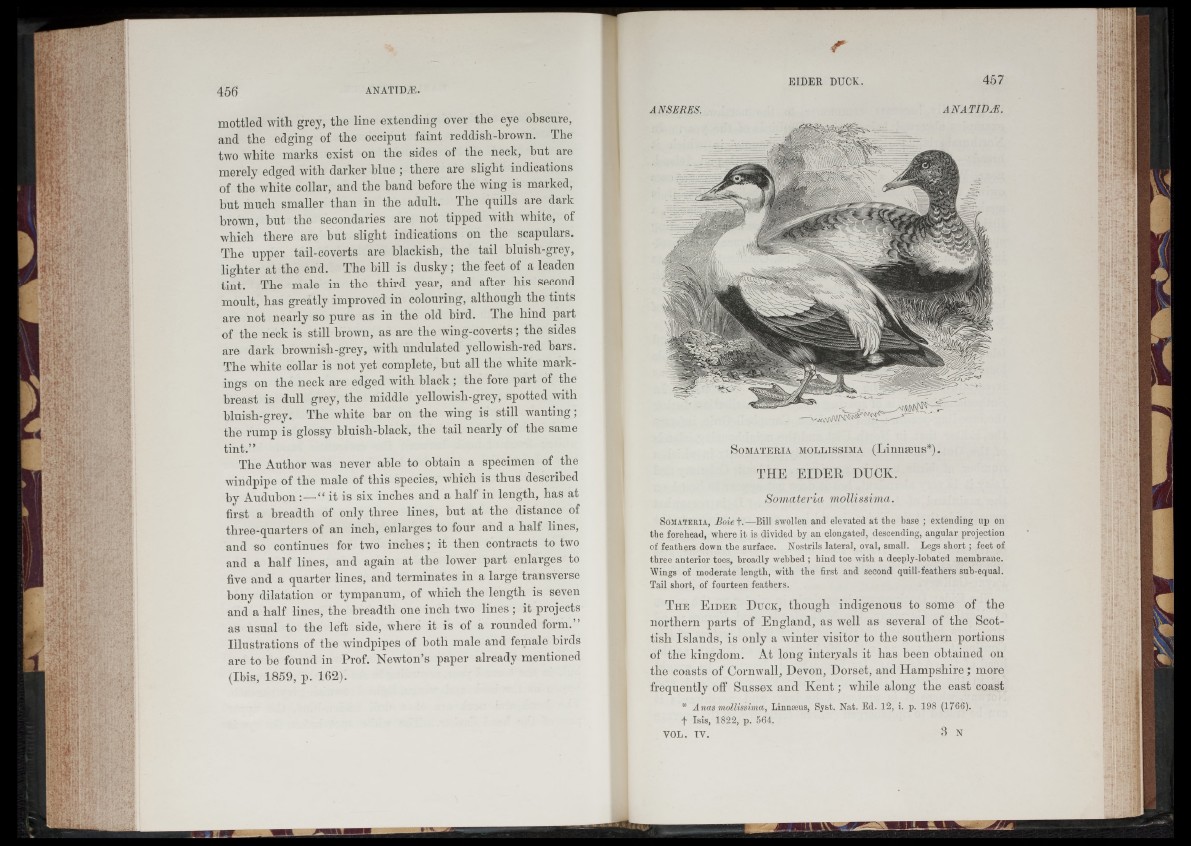
456 A N A T T D / E .
mottled with grey, the line extending over the eye obscure,
and the edging of the occiput faint reddisli-hrown. The
two white marks exist on the sides of the neck, hut are
merely edged with darker blue ; there are slight indications
of the white collar, and the hand before the wing is marked,
but much smaller than in the adult. The quills are dark
brown, hut the secondaries are not tipped with white, of
which there are hut slight indications on the scapulars.
The upper tail-coverts are blackish, the tail bluish-grey,
lighter at the end. The bill is dusky; the feet of a leaden
tint. The male in the third year, and after his second
moult, has greatly improved in colouring, although the tints
are not nearly so pure as in the old bird. The hind part
of the neck is still brown, as are the wing-coverts; the sides
are dark brownish-grey, with undulated yellowisli-red bars.
The white collar is not yet complete, but all the white markings
on the neck are edged with black ; the fore pait of the
breast is dull grey, the middle yellowish-grey, spotted with
bluish-grey. The white bar on the wing is still wanting,
the rump is glossy bluish-black, the tail nearly of the same
tint.”
The Author was never able to obtain a specimen of the
windpipe of the male of this species, which is thus described
by Audubon :—“ it is six inches and a half in length, has at
first a breadth of only three lines, but at the distance of
three-quarters of an inch, enlarges to four and a half lines,
and so continues for two incnes; it then contracts to two
and a half lines, and again at the lower part enlarges to
five and a quarter lines, and terminates in a large transverse
bony dilatation or tympanum, of which the length is seven
and a half lines, the breadth one inch two lines; it projects
as usual to the left side, where it is of a rounded form.
Illustrations of the windpipes of both male and female birds
are to be found in Prof. Newton’s paper already mentioned
(Ibis, 1859, p. 162).
SoMATERIA MOLLISSIMA (L im u e ilS * ).
THE EIDER DUCK.
Somatevia mollissima.
Somateria, Boie f .—Bill swollen and elevated a t th e base ; extending up on
the forehead, where i t is divided by an elongated, descending, an g u lar projection
of fea th ers down th e surface. Nostrils la te ra l, oval, small. Legs s h o r t ; fee t of
th ree an te rio r toes, broadly webbed ; h in d toe w ith a deeply-lobated membrane.
Wings of moderate length, with th e first an d second q u ill-fea th e rs sub-equal.
Tail short, of fourteen fea th ers.
T h e E i d e r D u c k , though indigenous to some of the
northern parts of England, as well as several of the Scottish
Islands, is only a winter visitor to the southern portions
of the kingdom. At long intervals it has been obtained on
the coasts of Cornwall, Devon, Dorset, and Hampshire ; more
frequently off Sussex and Kent; while along the east coast
* Anas mollissima, Linnasus, Syst. N at. Ed. 12, i. p. 198 (1766).
f Isis, 1822, p. 564.